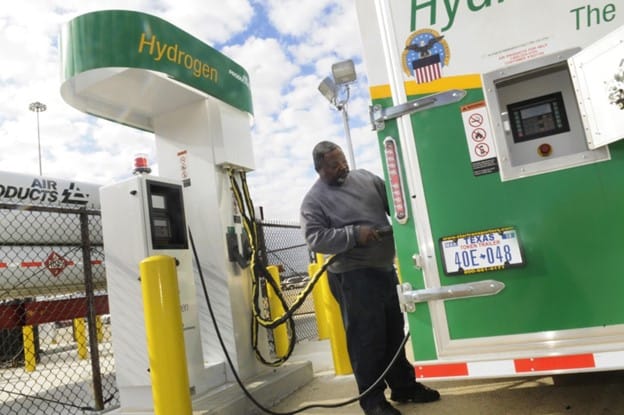Fuel of the future?
Fuel of the future? Green Hydrogen is a pivotal pillar in long-term decarbonization efforts worldwide. 80 countries are focused on hydrogen strategies. Is it time to add it to your investment portfolio?

Unveiling the Power of Hydrogen
Hydrogen, the most abundant chemical element in the universe, comprising 75% of all matter, is a key player in the quest for sustainable and commercially viable solutions. This colorless, odorless, and tasteless gas, primarily found in water, Green hydrogen takes center stage as a pillar in long-term decarbonization efforts worldwide.
The Global Imperative
Clean hydrogen emerges as a catalyst for reducing emissions across various sectors, particularly in challenging-to-decarbonize areas like heavy-duty transportation, chemical manufacturing, steel production, and more. As the world shifts to address decarbonization from a global perspective, green hydrogen proves to be critical in aligning environmental goals and creating hundreds of thousands of new job opportunities.
What Makes Hydrogen Green?
While 95% of hydrogen today is produced with fossil fuels conventionally and utilized in diverse industrial processes, green hydrogen sets itself apart. Produced through water electrolysis (i.e. split water into hydrogen and oxygen) powered by renewable energy, it boasts minimal to no carbon emissions. Despite its current dominance in a few industrial applications, the goal is to scale up its production significantly, especially in sectors challenging to decarbonize.
The Global Landscape
Approximately 50 countries have developed low-emission hydrogen strategies, with specific targets, while 18 others have broader hydrogen strategies without specific commitments. An additional 13 countries are in the process of formulating their hydrogen strategies.

Overcoming Challenges
Despite its promise, over 90% of hydrogen projects are yet to reach an agreement to start. The challenges lie in the lack of committed customer contracted demand and the pricing competitiveness against traditional fuels. Standard & Poor's (S&P) estimates the cost of producing hydrogen from renewables must decrease by over 50% for it to be a viable alternative compared to traditional fuels. The green hydrogen process is also a water-intensive process, so areas with water shortages will challenge the viability of certain plant locations.
Currently, 95% of hydrogen is both made and used in the same places, limiting the need for advanced transport and storage. The production methods produce hydrogen gas, making compression the easiest for storage and transport. However, hydrogen as a gas has low energy density, requiring more volume for the same energy as natural gas.
To overcome this, alternative transport methods need to be considered by liquefying hydrogen or converting it to ammonia. Ammonia can be used by power companies to burn ammonia gas turbines to generate power and sea ports can use ammonia for shipping. Ammonia serves as a precursor in the production of fertilizers.
Global Government Impetus
Various legislative acts globally are driving the change towards green hydrogen. In the U.S., the Inflation Reduction Act, historical pivotal legislation offering a clear roadmap for systematic decarbonization of the U.S. economy, allocates $7 billion to accelerate projects, including seven regional clean hydrogen hubs and estimates the creation of over 330,000 new jobs. Canada mirrors this effort with a $4 billion green hydrogen push and $13 billion in tax credits.
In the United Kingdom, the government has instituted a mechanism that will cover the difference between the achieved low-carbon hydrogen sales price and a predetermined price of natural gas. The floor for this arrangement is set by the natural gas price. Essentially, it provides financial support to ensure the viability and competitiveness of low-carbon hydrogen in the market. Interestingly, the sustainable benefits will translate to the end customers, for example, Diageo, the world's largest drinks company, has committed to green hydrogen to produce up to 200 million net-zero glass bottles.
The European Hydrogen Bank dedicates €3 billion to back consumption needs. European Union (EU) directives set ambitious targets. As part of its broader initiatives to attain climate neutrality by 2050 in alignment with the European Green Deal, the EU has crafted a comprehensive hydrogen strategy. This strategy aims to facilitate the transition of the continent towards a decarbonized economy. Recognizing hydrogen as a pivotal element in achieving climate neutrality, the EU's strategy provides a detailed roadmap for the development and deployment of hydrogen technologies. The revised directive raises the EU's renewable energy target for 2030 to a minimum of 42.5%, with a particular emphasis on increasing renewable energy use in industry and a binding target for renewable hydrogen consumption.

Market Growth
Hydrogen, with its potential for low or emission-free energy, is gaining attention globally. Currently, less than 1% is produced from green sources, but the International Energy Agency forecasts from announced new projects a 200% increase in low-emission hydrogen production capacity by 2030. Industries worldwide are committing to more green renewable hydrogen to decarbonize hard-to-abate sectors such as aviation, shipping, heavy industry, and freight.
The focus extends beyond sustainability to include energy security. Green hydrogen emerges as a crucial energy solution, aiming to reduce reliance on fossil fuels, such as Russia for European gas, especially given the ongoing Russian invasion of Ukraine.
Countries are aiming to foster the development of domestically produced green hydrogen to diminish the economic dependence on external nations for energy.
Invest In Decarbonization
The decarbonization potential of hydrogen is significant, but its effectiveness hinges on how carbon-intensive its production is. Green hydrogen, as a fuel source, is relatively easy to store (with some caveats), produces minimal pollutants, and can be applied across various sectors, from transportation to heavy industry. While hydrogen holds the promise of becoming a versatile global commodity, overcoming substantial infrastructure challenges is essential for this potential to be realized.

Fun Fact
The range of a hydrogen fuel cell truck can be up to 650 miles (1,000 km) on one tank of hydrogen and refueling can be done in less than 15 minutes. Having the capability to cover the same distances as their diesel counterparts will be necessary for zero-emission trucking.
Free newsletter content
Every two weeks with our newsletter distribution, we will discuss the market trends in one of our six themes below:
1. Renewable Energy (think solar, wind, hydroelectric)
2. Resources (think hydrogen)
3. Circular Economy (think water)
4. Energy Storage (think battery power grid)
5. Carbon Capture and Storage (think Carbon dioxide CO2 capture)
6. Green Transportation (think electric vehicles)
Premium newsletter summary
With paid content, you can access our select investments now. They are ready to invest today with no minimum investment amounts and they are accessible in established liquid stock markets to easily buy or sell your investments at any time. Make it your monthly habit!
We also include their Environmental, social, and governance (ESG) score. The ESG data focuses on sustainability, diversity, human rights, license to operate, business ethics, and corporate governance. Using 630 metrics, ESG scores provide a comparison of a company's practices with their industry peers.
Return Habit donates 2% of annual profits to underserved communities for green jobs and education. These jobs and training are critical for our community and economy.
